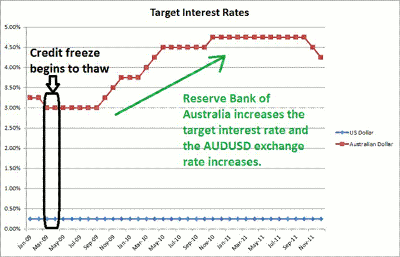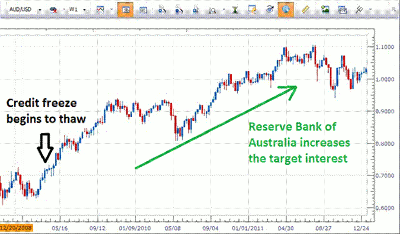Jeremy Wagner of DailyFX.com explains how currency traders can take advantage of interest rate movements.
Many FX traders get confused about which fundamental news releases to focus on when making a trading decision. I suggest to these traders to follow news releases that potentially impact the currency’s interest rate. This article will explain why the interest rate movements are important to the value of the currency.
Each currency carries with it an interest rate. This is almost like a barometer of that economy’s strength or weakness.
As a nation’s economy strengthens over time, prices tend to rise as the consumers are able to spend more of their income. The more we make, the better our vacations can be, and the greater amount of goods and services we are able to consume.
This creates a loop where more money chases roughly the same amount of goods, which can lead to higher prices for those goods. The rise in prices is called inflation.
If inflation is allowed to run rampant, our money will lose much of its buying power, and ordinary items such as a loaf of bread may one day rise to unbelievably high prices such as $100 per loaf. It sounds like an unlikely far-fetched scenario, but this is exactly what occurs in nations with very high inflation rates, such as Zimbabwe. To stop this danger before it emerges, the central bank steps in and raises interest rates in order to stem inflationary pressures before they get out of control.
Higher interest rates make borrowed money more expensive, which in turn dissuades consumers from buying new homes, using credit cards, and taking on any additional debts. More expensive money also discourages corporations from expansion, as so much business is done on credit, from which interest is always charged.
Eventually, higher rates will take their toll as economies slow down, until a point where the Central Bank will begin to lower interest rates. This time, the reduction in rates is to encourage economic growth and expansion. The Central Bank has a delicate balance of trying to foster growth while at the same time keeping inflation low.
A side effect of high interest rates is that foreign investors desire to invest in that country. The logic is identical to that behind any investment. The investor seeks the highest returns possible.
By increasing interest rates, the returns available to those who invest in that country increase. Consequently, there is an increased demand for that currency as investors invest where the interest rates are higher.
Countries that offer the highest return on investment through high interest rates, economic growth, and growth in domestic financial markets tend to attract the most foreign capital. If a country’s stock market is doing well and they offer a high interest rate, foreign investors are likely to send capital to that country. This increases the demand for the country’s currency, and causes the currency’s value to rise.
As you can see, it is not just the rate itself that is important. The direction of the interest rate can act as a good proxy for demand for the currency. The direction of the interest rate is obtained through the central bank’s language in the statement that accompanying their target rate decision.
The accompanying statement is analyzed word-for-word for any signs of what the central bank may do at the next meeting. Remember, the interest rate decision itself tends to be less important than the expectations for future interest rate moves.
High and increasing rates at the beginning of an economic expansion can generate growth and value in a currency. On the other hand, low and lowering rates may represent a country experiencing difficult economic conditions, which is reflective in a reduction of the currency value.
The Widening Interest Rate Differential
In early 2009, the worldwide economy was bottoming out as the United States credit freeze began to thaw. The Fed kept US interest rates at all-time lows, while the Reserve Bank of Australia began their process of increasing their target benchmark rate.
Since this was in the beginning of an economic expansion, foreign investors into Australian companies needed Australian dollars to make their investment. Additionally, FX traders began buying the AUD/USD currency pair in anticipation of this demand for the Australian dollar.
Those traders were rewarded as the AUD/USD exchange rate began a 30-cent rise while earning an additional daily dividend from 2009 through 2011. One mini lot trade of 10,000 units of currency would have yielded over $3,000 plus interest.
Jeremy Wagner can be found at DailyFX.com.























